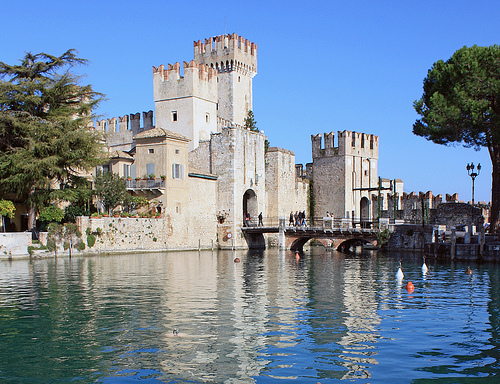

Location: Sirmione, Lombardy Map
Constructed: 13th century
Tel. 030 91 64 68
Open: Tue- Sun
Sirmione Castle is located in a commune of Sirmione, Lombardy region of Italy. Sirmione Castle was constructed in the 13th century on a strategic Sirmio peninsula on the lake Garda on a site of the settlement that was occupied intermittently since the 6th millennia BC. Poet Catullus described the settlement and praised its beauty and magnitude. During Ancient Roman period a Sirmione Fortress was erected here to defend surrounding lands. It didn't stop the barbarian Lombard tribe that settled here and further increased their defenses. The construction of a new medieval stronghold began around 1259 by the orders of Mastino I della Scala. Around that time the Sirmione Castle became a safe haven for the Patarines, heretics that wanted to reform Roman Catholic Church and its way of life. One of the advantages of having a protected harbor is ability to flee enemies on light and quick ships across the lake. Sirmione Castle lost much of its military importance by the early 16th century, although its living quarters were used as a barrack for the small military garrison. Today Sirmione Castle is turned into a museum under supervision of Superintendency of Architectural Monuments.
The castle is bathed on all sides by the waters of Lake Garda, and on
one of these sides, shortly after the construction of the castle, the
dock was built, which once represented the place of refuge for the
Scaliger fleet.
The walls and the three massive main towers are
characterized by the dovetail battlements that distinguish every
Scaliger building: behind these three towers emerges the imposing keep,
47 meters high, under which the cells intended for prisoners were
located.
Once the fortress could be accessed both from outside
the town and from the village itself via drawbridges, while today it is
only possible to enter from the village. Through doors equipped with
effective closing systems, one enters the large portico, inside which
stands a staircase leading to a drawbridge. From here, via a flight of
146 steps, you can reach the patrol walkways of the walls, from which
you can appreciate the dock. The dock is also defended by towers which,
however, unlike those inside the castle, are not characterized by
dovetail battlements but by a basic structure known as a spearhead. This
feature, together with the use of bricks and stones from nearby areas,
denote a different period of construction. On one side of the dock there
is an external moat that flows directly into the lake.
The construction of the fortress began around the middle of the
thirteenth century, probably on the remains of a Roman fortification.
Its construction was ordered by the mayor of Verona Leonardino della
Scala, better known as Mastino della Scala. The function of the castle
was defensive and port control, since the city of Sirmione, being in a
border position, was more exposed to aggression.
About a century
later, two courtyards and an independent fortification were added,
joined by a barbican to the main one, to increase the defenses of the
fortress. In 1405 Sirmione passed under the control of the Republic of
Venice during which domination work began to strengthen the defensive
structures. It was in this period that the dock visible today was built,
even if it is assumed that a Scaliger dock, probably wooden, was already
present. Sirmione maintained its primacy as a defensive post until the
16th century, when, for political reasons, the fortress of Peschiera del
Garda was modernised.
Inside the large internal portico of the castle, a Roman and medieval lapidary has been set up, as well as a brief exhibition in which the most important information on the fortress is shown on some panels. You can also access the walkways of the walls and, via recently restored flights of wooden stairs, you can reach the top of the keep, the highest tower of the fortress.
In 1980, the Italian Post Office dedicated a 600 lire stamp to the castle, which was part of the collection known as "Castelli d'Italia".
It tells of a boy named Ebengardo with his sweetheart Arice: the two
young men spent a peaceful life, until their love affair was interrupted
by a tragic episode. During a stormy night he asked for shelter in the
Elalberto castle, a Venetian knight from the Feltre area. The couple
hosted the knight who, however, was amazed by the girl's beauty, joined
her in her room during the night. Arice started screaming scared and
terrified and so Elalberto stabbed her. Meanwhile Ebengardo ran into the
room where he found Arice lifeless, so it was that, blinded by rage, he
seized the dagger and killed Elalberto.
Legend has it that even
today, on stormy nights, Ebengardo's soul can be seen wandering around
the castle in search of Arice.